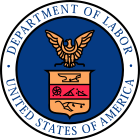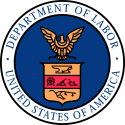Bureau of International Labor Affairs
 | |
| Bureau overview | |
|---|---|
| Formed | October 10, 1947 |
| Headquarters | Frances Perkins Building |
| Annual budget | $83 million (2009)[1] |
| Bureau executives |
|
| Parent Bureau | United States Department of Labor |
| Website | https://www.dol.gov/agencies/ilab |
The Bureau of International Labor Affairs (ILAB) is an operating unit of the United States Department of Labor which manages the department's international responsibilities. According to its mission statement:
“The Bureau of International Labor Affairs leads the U.S. Department of Labor's efforts to ensure that workers around the world are treated fairly and are able to share in the benefits of the global economy. ILAB's mission is to improve global working conditions, raise living standards, protect workers' ability to exercise their rights, and address the workplace exploitation of children and other vulnerable populations. Our efforts help to ensure a fair playing field for American workers and contribute to stronger export markets for goods made in the United States.” [2]
ILAB promotes the economic security and stability of United States workers in international affairs and provides advice and statistics on policy decisions which have U.S. labor concerns. The Bureau also represents the United States at trade negotiations and at international bodies like the
The Bureau of International Labor Affairs is located in the Frances Perkins Building, Room S-2235, 200
History
The Bureau of International Labor Affairs was formed October 10, 1947, during the administration of
Child labor, human trafficking and forced labor
In 1993, the United States Congress directed the Secretary of Labor, Robert Reich at the time, to identify foreign industries and countries which export goods to the United States which were produced using child labor. Responsibility for this project was given to ILAB which published the first of its reports on the subject: The Sweat and Toil of Children: The Use of Child Labor in American Imports.[3]
In 1999, President
On April 10, 2009, the Bureau of International Labor Affairs announced a letter of intent to "Fund International Child Labor Elimination Projects in Fiscal Year 2009" this involves the awarding of merit-based "cooperative agreement awards" to organizations seeking to fund projects to combat child labor through education. It is intended that $20 million be budgeted for this purpose. These efforts will be focused in the countries of Guatemala, Indonesia, Nepal, and Rwanda.
International technical cooperation
ILAB provides technical assistance with other countries in the areas of technical expertise, worker health, and working conditions with the goal of benefiting U.S. foreign policy. This program began in the aftermath of World War II when the Department of Labor taught German trade unionists to assist in European reconstruction efforts.
In 1975, ILAB worked with the Government of
Offices
- Office of the Deputy Under Secretary for International Affairs (ODUS)
- Office of Child Labor, Forced Labor, and Human Trafficking (OCFT)
- Research and Policy Division
- Monitoring and Evaluation Division
- Asia/Europe/MENA Division
- Latin America and the Caribbean Division
- Africa Division
- Office of Trade and Labor Affairs (OTLA)
- Trade Policy and Negotiations Division (TPN)
- Monitoring and Enforcement of Trade Agreements Division (META)
- Technical Assistance and Cooperation Division (TAC)
- Office of International Relations (OIR)
- Multilateral and Global Issues Division
- Office of Economic and Labor Research (OELR)
Related legislation
- Executive Order 13126
- Farm Bill”)
- Trafficking Victims Protection Reauthorization Act(TVPRA)
See also
- United States Department of Labor
- United States Department of State
- Harkin-Engel Protocol
- Child Labor
- Children in cocoa production
References
- ^ a b c Bureau of International Labor Affairs, "Bureau of International Labor Affairs Assessment" Washington, DC: U.S. Department of Labor, Accessed 25 June 2013.
- ^ United States. Bureau of International Labor Affairs (ILAB). "Bureau of International Labor Affairs Mission Statement" Archived 2016-04-15 at the Wayback Machine Washington, DC: U.S. Department of Labor, Accessed 10 April 2014.
- ^ a b United States. Bureau of International Labor Affairs (ILAB).Bureau of International Labor Affairs: A Brief Outline of Principal Activities. Washington, DC: Department of Labor, 1994.
- ^ United States. Bureau of International Labor Affairs (ILAB). "Lewis B. Schwellenbach" Archived 2008-09-29 at the Wayback Machine, Washington, DC: U.S. Department of Labor, Accessed 25 June 2013.
- ^ a b c United States. Bureau of International Labor Affairs (ILAB). "Executive Order 13126" Archived 2009-01-30 at the Wayback Machine Washington, DC: U.S. Department of Labor, 2013. Accessed 25 June 2013
- ^ United States. Bureau of International Labor Affairs (ILAB). "International Cooperation Program" Archived January 7, 2009, at the Wayback Machine Washington, DC: U.S. Department of Labor, 2013, Accessed 25 June 2013.
- United States. Bureau of International Labor Affairs (ILAB).Bureau of International Labor Affairs: A Brief Outline of Principal Activities. Washington, DC: Department of Labor, 1994.
External links
- United States Department of Labor Official Website
- Bureau of International Labor Affairs Official Website
- Selected Bureau of International Labor Affairs Publications and Documents
- Official Website of the International Labour Organization (ILO)
- US Department of State Office to Monitor and Combat Trafficking in Persons Website (G/TIP)

